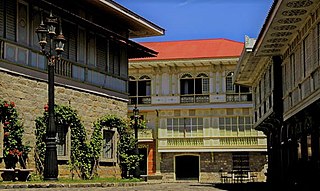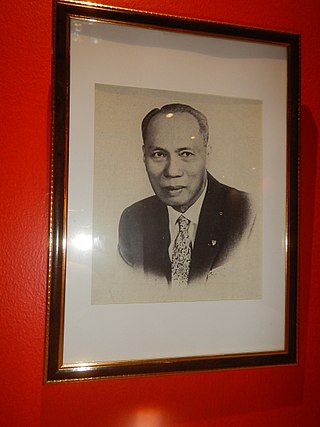Related Research Articles

Laguna, officially the Province of Laguna, is a province in the Philippines located in the Calabarzon region in Luzon. Its capital is Santa Cruz while its largest city is the City of Calamba and the province is situated southeast of Metro Manila, south of the province of Rizal, west of Quezon, north of Batangas and east of Cavite. Laguna hugs the southern shores of Laguna de Bay, the largest lake in the country. As of the 2020 census, the province's total population is 3,382,193. It is the seventh richest province in the country in 2016.

Rizal, officially the Province of Rizal, is a province in the Philippines located in the Calabarzon region in Luzon. Its capital is the city of Antipolo. It is about 16 kilometers (9.9 mi) east of Manila. The province is named after José Rizal, one of the main national heroes of the Philippines. It is bordered by Metro Manila to the west, Bulacan to the north, Quezon to the east and Laguna to the southeast. The province also lies on the northern shores of Laguna de Bay, the largest lake in the country. Rizal is a mountainous province perched on the western slopes of the southern portion of the Sierra Madre mountain range.

Santa Cruz, officially the Municipality of Santa Cruz, is a 1st class municipality and capital of the province of Laguna, Philippines. According to the 2020 census, it has a population of 123,574 people.

Juan Marcos Arellano y de Guzmán, or Juan M. Arellano, was a Filipino architect, best known for Manila's Metropolitan Theater (1935), Legislative Building, the Manila Central Post Office Building (1926), the Rizal Memorial Sports Complex (1934), the Central Student Church, the old Jaro Municipal Hall (1934) and the Old Iloilo City Hall (1935) in Iloilo, the Negros Occidental Provincial Capitol (1936), the Cebu Provincial Capitol (1937), the Bank of the Philippine Islands Cebu Main Branch (1940), Misamis Occidental Provincial Capitol Building (1935), Cotabato Municipal Hall (1940) and the Jones Bridge during the pre-war era.

The architecture of the Philippines reflects the historical and cultural traditions in the country. Most prominent historic structures in the archipelago are influenced by Austronesian, American architectures.

The Manila Metropolitan Theater, also known as the Metropolitan Theater, abbreviated as the MET, is a historic Philippine Art Deco building located in Plaza Lawton in Ermita, Manila. It is recognized as the forefront of the Art Deco architectural style in the Philippines.

Juan Felipe de Jesús Nakpil, KGCR, KSS known as Juan Nakpil, was a Filipino architect, teacher and a community leader. In 1973, he was named one of the National Artists for architecture. He was regarded as the Dean of Filipino Architects.

Fernando Hizon Ocampo, Sr. was a Filipino architect and civil engineer.

The Manila Central Post Office, often called the Post Office Building, is the main postal office of Manila, which also serves as the headquarters of the Philippine Postal Corporation. It also houses the main mail sorting-distribution operations of the Philippines.

Caliraya Dam is an embankment dam located in the town of Lumban province of Laguna, in the Sierra Madre Mountain Range of the Philippines. The reservoir created by the dam, Lake Caliraya, initially supplied one of the oldest hydroelectric plants in the Philippines, and later became a popular recreational area for numerous water sports and fishing. The dam's construction was started in 1939 under the supervision of the architecture firm of Pedro Siochi and Company and a small hydroelectric plant was operated in 1942.

The Cebu Provincial Capitol is the seat of the provincial government of Cebu in the Philippines. Located at the north end of Osmeña Boulevard in Cebu City, it was designed by Juan M. Arellano, a Filipino architect best known for the Manila Metropolitan Theater (1935), the Legislative Building, and the Manila Central Post Office (1926). An inscription on the central concave portion of its façade reads, "The authority of the government emanates from the people. Erected A.D. MCMXXXVII."

The National Museum of Fine Arts, formerly known as the National Art Gallery, is an art museum in Manila, Philippines. It is located on Padre Burgos Avenue across from the National Museum of Anthropology in the eastern side of Rizal Park. The museum, owned and operated by the National Museum of the Philippines, was founded in 1998 and houses a collection of paintings and sculptures by classical Filipino artists such as Juan Luna, Félix Resurrección Hidalgo and Guillermo Tolentino.

Escolta Street is a historic east–west street located in the old downtown district of Binondo in Manila, Philippines. It runs parallel to the Pasig River, from Quintin Paredes Road to Plaza Santa Cruz Road. The street is home to several fine examples of early skyscraper design in the Philippines. In Spanish, it is known as calle de la Escolta. Its definition as a historic financial district includes Escolta and other surrounding streets of Binondo and Santa Cruz. It currently carries one-way eastbound traffic towards Santa Cruz.

The Philippine Institute of Architects (PIA) is an architectural society in the Philippines and is the oldest architectural society in Asia. It is composed of noble men and women from the architectural profession of the Philippines. It was founded by renowned architects in 1933 whose ultimate endeavor is the professional development of architecture in the Philippines.

Regina Building, previously known as Roxas Building, is a historic building located along Escolta Street in Binondo, Manila, Philippines. It was designed sequentially by Andrés Luna de San Pedro and Fernando H. Ocampo. The neoclassical beaux-arts commercial structure was built in 1915.

The following is an alphabetical list of articles related to the Philippine capital region of Metro Manila.
Philippines National Historic Landmarks is a registry of historic sites in the Philippines that have been officially declared by the Philippine Registry of Cultural Property.

The Iloilo Customs House is a historical building in Iloilo City, Philippines. It was built in 1916 to a design by American architect Ralph Harrington Doane, then Consulting Architect of the Bureau of Public Works in the Philippine Islands. Among the three American-era customs houses in the Philippines, it is the second largest and second oldest. The building is located at Muelle Loney Street and Aduana Street along the Iloilo River and still houses the offices of the Bureau of Customs and the Bureau of Immigration in Iloilo City.
References
- ↑ Wood, Leonard (1925). Annual report of the Governor General of the Philippine Islands. Washington D.C.: Washington G.P.O
- ↑ Lico, Gerard (2008). Arkitekturang Filipino: A History of Architecture and Urbanism in the Philippines. Quezon City: The University of the Philippines Press. p. 310. ISBN 978-971-542-579-7.
- ↑ Alarcon, Norma (2008). The Imperial Tapestry: American Colonial Architecture in the Philippines. Manila: University of Santo Tomas Publishing House.
- ↑ Montinola, Lourdes (2010). Art Deco in the Philippines. Manila: ArtPositAsia. ISBN 978-971-057-905-1
- ↑ de la Torre, Visitacion (1981). Landmarks of Manila: 1571-1930. Makati: Filipinas Foundation, Inc.